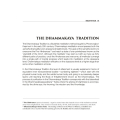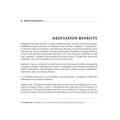Dakhina-vibhanga Sutta : ค้นหาหนังสือธรรมะ
หน้าหนังสือทั้งหมด

4
Essentials of Sutta Teaching
Contents
Preface........................................................................................................2
1. Udaya Sutta :
Breaking the Cycle..........................................
This book presents a collection of significant Suttas focusing on the themes of generosity, morality, and the principles of giving. Topics include the Udaya Sutta which discusses breaking the cycle of

38
The Virtue of Abstaining in Dakhina-vibhanga Sutta
The Virtue of Abstaining
6. Dakhina-vibhanga Sutta
the virtues loved by noble ones.24 It is owing to the Blessed One that Mahā paja pārī Gotāmī is fr…
The Dakhina-vibhanga Sutta highlights the significance of abstaining from harmful actions such as killing and immoral conduct.…

3
Analyzing the Dhammacakkappavattana Sutta: A Text-Critical Approach
The Document Research Methods
Case Study: The Dhammakakkappavattana Sutta
Pramaha Pongsak THANIO
Abstract
Dhammacakkappavattana Sutta (Sanskrit: Dharmacakaravartana
Sutra) is regarded as one of the
The Dhammacakkappavattana Sutta, a key Buddhist text, shows multiple versions arising after the Buddha’s death, raising authenticity questions. This research employs text-critical methods to establish

32
The Role of Mahā pajā pati Gotaṃi in Early Buddhism
21 Mahā pajā pati Gotaṃi was the younger sister of Queen Mahā mā yā the Buddha’s mother, and was also the wife of King Suddhodana. After Mahā mā yā’s death, she became the Buddha’s foster mother. The
Mahā pajā pati Gotaṃi, sister of Queen Mahā mā yā and wife of King Suddhodana, became the Buddha's foster mother after the queen's death. During the early days of the Buddha's teachings, she advocated

34
Understanding Dhammakāya in Early Buddhist Thought
II. The Different Approach
A fairly established academic understanding has settled regarding the term dhammakāya in the Pali canon, that it was used merely in the sense of the ‘Buddha’s teachings.’ In
The term 'dhammakāya' in the Pali canon is understood as representing the Buddha's teachings. It is established through several canonical passages that equate the Buddha with dhamma. Notable reference

36
References to 'Dhammakāya' in the Pāli Canon
III. References to 'Dhammakāya' in the Pāli Canon
In the Pali canon, the term dhammakāya appears four times: once in the Aggiāṇā-sutta of the Dīgha-nikāya and three more times in Apadāna literature.
In the Pāli Canon, the term 'dhammakāya' is found four times, significantly in the Aggiāṇā-sutta and Apadāna literature. It serves various roles including a designation for the Tathāgata and associati

37
Exploring the Concept of Dhammakāya in the Aggañña-sutta
IV. Reference 1: Dhammakāya as the Tathāgata’s Designation
The first Pali reference to the term dhammakāya that is well known to all previous works is a passage in the Aggañña-sutta, wherein the term
This text discusses the term 'dhammakāya' as referenced in the Aggañña-sutta, emphasizing its importance in defining an heir of dhamma and the Tathāgata’s true son. The conversation between the Buddha

39
Interpretations of Dhammakāya in Early Pāli Texts
Gombrich, while differently translating the term in this passage as a bahubbiha compound 'dhamma-bodied,' similarly interprets it as an indication that the Buddha's true import is due to 'his teaching
This text delves into various scholars' interpretations of the term 'dhammakāya' within the context of early Pāli suttas. Gombrich views it as 'dhamma-bodied,' emphasizing that the essence of the Budd

40
Understanding Dhammakāya in Aṅgāṇā-sutta
In brief, contemporary academics refer to the term dhammakāya in the Aṅgāṇā-sutta either as a noun or an adjective. As a noun, the term is interpreted mostly as the Buddha’s teachings collected togeth
The term dhammakāya is interpreted in contemporary academia as both a noun and an adjective. As a noun, it denotes the Buddha’s teachings, while as an adjective, it refers to the nature of the Tathāga

71
Understanding Dhammakāya and Enlightenment
1. The term dhammakāya is related to enlightenment. This agrees with our earlier observation regarding the relation of ‘dhammakāya’ to the Buddha and Paccakabuddhas.
2. Dhammakāya is not exclusive to
The term 'dhammakāya' signifies enlightenment and is not exclusive to the Buddha but can also be attained by his disciples, as indicated by Gotami's reference to 'my dhammakāya.' This term is interpre

6
Payasi Sutta: Rebirth and Karma
This Life Next Life
Payasi Sutta
(Rebirth and Karma)
Thus have I heard.
1. The venerable Kumara Kassapa¹ was once walking on tour in Kosala together with a great company of bhikkhus, to the number o
The Payasi Sutta recounts the teachings of venerable Kumara Kassapa during his time in Setavya. It narrates the challenges faced by Payasi, a chieftain in this city, as he grapples with misconceptions

40
The Verse of Abandoning: Dakkhināvíbhanga Sutta
The Verse of Abandoning
6. Dakkhināvíbhanga Sutta
"When one person, owing to another, has come to possess unwavering confidence in the Buddha, the Dhamma, and the Sangha, and to possess the virtues
The Dakkhināvíbhanga Sutta emphasizes the significance of unwavering confidence in the Buddha, Dhamma, and Sangha. It illustrates how one person's faith and understanding can be influenced by another,

54
The Purification of Offerings in Dakhināvíbhanga Sutta
54
The Virtue of Absolving
6. Dakhināvíbhanga Sutta
13. "And how is the offering purified both by the giver and by the receiver? Here the giver is virtuous, of good character, and the receiver is
The Dakhināvíbhanga Sutta presents insights on how offerings are purified based on the character of both the giver and receiver. It delineates scenarios: when a virtuous giver offers to an immoral rec

66
The Virtue of Approving in Velāma Sutta
66
The Virtue of Approving
7. Velāma Sutta
"Now, householder, if the thought should occur to you,
'Perhaps it was someone else who at that time was
Velāma the brahman, who gave that gift, t
In the Velāma Sutta, the householder is reminded that true merit comes not from the quantity or grandeur of gifts, but from the character and realization of those who receive them. The teaching emphas

72
Velama Sutta: The Power of Good Will
The Voice of Abstaining
7. Velama Sutta
“If one were to develop even just one whiff of a heart of good will, that would be more fruitful than... if one with a confident mind were to undertake the tra
This text discusses the teachings of the Velama Sutta, emphasizing that developing even a small amount of good will is more fruitful than significant material offerings and merits. It illustrates how

85
The Dhammakaya Tradition
The Dhammakaya Tradition
The Dhammakaya Tradition is a Buddhist meditation method taught by Phramongkolthepmuni in the early 20th century. Dhammakaya meditation encompasses both the samatha (tranquili
The Dhammakaya Tradition is a renowned Buddhist meditation technique initiated by Phramongkolthepmuni in the early 20th century, blending samatha and vipassana practices with the aim of overcoming the

90
Meditation Benefits
86 MEDITATION BENEFITS
MEDIATION BENEFITS
Meditation has been linked to a variety of health benefits. A review of scientific studies
identified favorable outcomes of meditation which include: relaxa
Meditation is associated with various health benefits such as relaxation, concentration, and increased awareness. Scientific studies reveal its positive impact on metabolism, heart rate, and brain act

59
The Importance of Chanting in Buddhism
your mind will clear and be open to receive merit. Your thoughts, speech, and action will not be led astray by temptation.
Performing Vatta serves constantly to remind us of the virtues of the Triple
Chanting in Buddhism plays a crucial role in enhancing faith and preserving teachings of the Buddha. It reminds practitioners of the virtues of the Triple Gem and helps them avoid temptation. Historic

18
The Arrival of Celestial Chariots
While the monks were reciting the Mahasatipatthana Sutta,
six decorated chariots from six celestial worlds arrived to invite him to their respective worlds. Dhammika told them to wait for a while for
In this passage, while the monks recite the Mahasatipatthana Sutta, six celestial chariots from different worlds arrive to invite Dhammika to join them. Dhammika requests them to wait, fearing the dis

208
Pali Texts and Commentaries
VoIs.1-2, eds. Max Walleser and Hermann Kopp. London: Luzac&Company, Ltd, 1924-1930; Vols. 3-5, ed. Hermann Kopp. Oxford: The Pali Text Society, 1936-1957.
Nettipakarana with Extracts from Dhammapāla
This document provides a detailed listing of significant Pali texts, their editions, and the editors involved in their publication. The Pali Text Society has played a crucial role in preserving and di
